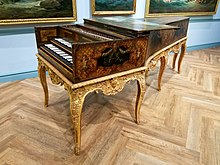This article has multiple issues. Please help improve it or discuss these issues on the talk page. (Learn how and when to remove these messages)
|

Jean-Henri Hemsch (21 February 1700 – September 1769), known in German as Johann Heinrich Hemsch (alternate spelling: Johannes Heinrich Hembsch), was a French harpsichord maker of German origin.
Biography
Hemsch was born in Kastenholtz, near Cologne, and moved to France in 1728 where he completed a six-year apprenticeship under Antoine Vater, another German émigré harpsichord maker. Following this, he established his own workshop in Rue Quincampoix, Paris with his younger brother Guillaume (1734–1776), and served a two-year term as juré of the instrument makers' guild from 1746.
Hemsch died in Paris and was succeeded by his nephew Jean-Henri Moers (1754–1793). He is celebrated as one of the most important harpsichord builders of his milieu.
Six of his double-manual harpsichords have survived:
· a lavishly decorated instrument in brown and gold from 1736 (Museum of Fine Arts, Boston)
· a white instrument with a lid painting and gilding from 1751 (currently owned by the harpsichordist Frédérick Haas)
· a black and red instrument with gold bands from 1754 (Bayerisches Nationalmuseum)
· a green and red instrument with subtle gilding from 1755/6 (current location unknown)
· a black and red instrument with a blank lid from 1761 (Cité de la Musique, Paris)
· a lavishly decorated ravalement double-manual harpsichord from 1763 based on a 1636 Andrea Ruckers harpsichord (Cobbe Collection, Hatchlands Park)
His harpsichords are similar to those of Vater and French in style, with two manuals, three-register disposition with shove coupler, and a compass of FF–e''' (rising to f''' on the 1761 and the 1763 ravalement).
Guillaume Hemsch
Three further instruments bearing the Hemsch name have survived, all of which were completed by Guillaume:
· a double-manual harpsichord from 1763 (current location unknown)
· a fake "1636" Ruckers from 1766, the soundboard of which was probably built from a seventeenth-century Flemish muselaar (current location unknown)
· an undated fake "1628" Ruckers (current location unknown)
See also
Notes and references
- John Koster: 'Hemsch, Henri ', Grove Music Online ed. L. Macy (Accessed 2007-05-18), http://www.grovemusic.com/ Archived 2008-05-16 at the Wayback Machine